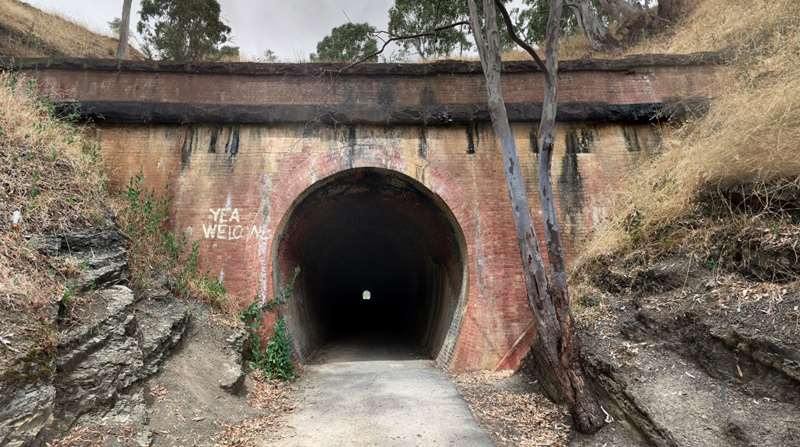Yea - Cheviot Tunnel


The historic Cheviot Rail Tunnel is a key feature of the Tallarook to Mansfield Rail Line which operated between 1883 and 1970. Being the only tunnel on this line, and made using handmade bricks using local clay, which remain in excellent condition today it has tremendous heritage values.
The 201 m (660') long Tunnel was constructed to pass trains across the Black Range at McLoughlin's Gap roughly half way between Yea and Molesworth.
Built under tender by Kenny Bros. as part of the Yea to Cathkin section at a cost of f88,661/2/11 the work was delayed by accidents, floods and several industrial incidents.
The tunnel was constructed from an estimated 675,000 handmade bricks using local clay. This was sourced from Quinlan's pit in a nearby paddock just west of the Tunnel. Some steel hooks that held lanterns in emergencies still exist near the four indented safety alcoves. These are located at regular intervals along the eastern wall.
Unfortunately there were several casualties during construction. A serious explosion on 14th December 1887, killed Peter Byrne, aged 24, and two other men were injured. One of these, John Jordan, was transported by train to the Royal Melbourne Hospital where he later died from his injuries. Another worker named Fennel, was buried under rock and suffered severe bruising. Peter Byrne is buried in Yea Pioneer Cemetery where his workmates erected an imposing tombstone. Daniel Driscoll, another 24 year old died of injuries suffered from a rock fall in May 1899.
The rail line from Tallarook to Yea opened on Friday 16th November 1883 with the Yea Station being the terminus for 6 years. Consequently, Yea became the base for train crews and locos and the town prospered. The brick Station buildings at Yea were part of the tender. The Refreshment Rooms operated from 1891 and the Yea to Molesworth extension finally opened on 12th November 1889.
Yea is 133km (83 miles) by rail from Melbourne and sits at an elevation of 172m (565 feet). The line to Mansfield crossed the Yea River flats over a mile-long wooden trestle bridge before commencing a three mile climb up an almost continuous 1:40 grade with many curves to the Cheviot Tunnel.
The grade was only briefly broken at Cheviot station where it reduced to 1:200 so that trains could start and stop safely. The tunnel itself lies on a 1:60 grade. The top of the grade is at the eastern end of the tunnel at an elevation of 283m (927 feet).
Having breasted the summit, the hardworking fireman of a steam locomotive received respite as the train traversed the five miles of downgrade, three miles of it at 1:40 to Molesworth Station (elevation 569 feet). Several rail accidents occurred at Suicide Bend (near Sheepwash Lagoon) as trains descended from the Tunnel at speed to Molesworth. Immediately beyond Molesworth the railway crossed the Goulburn River.
Over the years several of the wooden bridges were damaged by fires. These were gradually replaced with concrete culverts. The continuous timber pile bridge over the Yea River flats was replaced in 1946-47 by concrete and steel bridges interspersed across several earthen embankments.
Passenger services ceased on May 27, 1977. The line was officially closed on November 8, 1978.
Timber Railways
The Cheviot Station, just 5.5km (3.4 mile) west of the tunnel, was built to load sawn timber harvested from the Murrindindi Forest, some 23km (14 mile) away, The timber was loaded and transported to the station by horse-drawn wagons. Cheviot Station opened with the rail line in 1889.
The first 3' (0.9m) gauge timber tramway opened in 1901 and led to a terminus some 8km (5 miles) from the Station. It was extended to the Station in 1905. A second tramline commenced operation in 1925. Both tramways stopped operation in 1937 when the horse-drawn wagons were replaced by trucks.
Two six ton derrick cranes were installed at the station yards in the 1920's to handle the large volume of timber transported. Foran (1889-1890), Vinning (1892-1906), Wightman (1893-1901), and McKenzie (1899-1901) were the major milling companies that operated in the early years. The timber industry around Yea peaked between 1907 -1915 just as the Great War saw many men enlist. This was followed by another boom period between 1923 - 1930 before the Depression caused production to reduce greatly and demand for timber fell.
Directions
The easiest route is to take the Goulburn Valley Highway east out of tea. After a few kilometres, there is a sign to Cheviot Tunnel on the right. Take Limestone Road for 2.8km and then turn left onto Cheviot Road. After 3.8km there is a carpark close to the tunnel. Look out for the Great Victorian Rail Trail sign because there is no signage to the parking area which is about 80m from the tunnel entrance.
Location
Cheviot Road, Limestone 3717 Map











